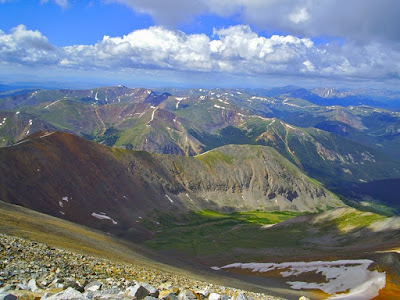Elevation: 7, 127 ft - 7,658 ft
Elevation Gain: 816 ft (cumulative)
Date Hiked: 19 June, 2011
Dogs: On leash only
Bathroom at the trailhead: port-o-let only
The Spruce Mountain Loop in the Spruce Mountain Open Space in Douglas County traverses a large sandstone mesa within spitting distance of I-25 but it feels worlds away. South of Castle Rock and west of Larkspur, this was a total find for someone who lives north of Denver. I loved this trail and can't wait to take others on it. This would also be a great trail run for those who also enjoy such things.
 Example of the trail signage. This is the junction with the Spruce Meadow Trail where I took a left.
Example of the trail signage. This is the junction with the Spruce Meadow Trail where I took a left.The vegetation on the mesa is a unique combination of Scrub Oak, Douglas Fir, and Ponderosa Pine. Once on the mesa, the route navigates the edges with many overlooks on sandstone promontories overlooking pastoral ranch land. For those who love alfresco dinning this Open Space has more places to choose from than you will ever need.
I had a hard time finding the trailhead for this open space because a prominent guide book mentioned that it was 1.25 miles out of Larkspur on Spruce Mountain Road. It is actually 3.5 miles beyond the railroad bridge at the edge of the city limits. I kept turning around thinking I had missed it. The moral of the story is keep driving. The trailhead is very obvious with a large metal sign.
20 yards beyond the western exit from the parking lot is a sign pointing out trail options. While the Spruce Mountain Loop technically starts straight ahead, I chose instead to take an immediate left, which is on the Spruce Meadow Trail, and head up the hill that everyone seemed to be coming down. It is a short 0.1 miles to a well marked trail called the Oak Shortcut. This trail quickly ascends another 0.1 miles through a gauntlet of Scrub Oaks to a junction. Take a left here and you are on the stem of the lollypop loop that traverses the mesa.
The next 0.7 miles is a series of switchbacks that wind gracefully up to the top of the mesa through a pleasant Douglas Fir forest. This trail is popular with equestarians who add on this loop the much larger Spruce Meadow Loop (which lazily wanders through the open grassland below), as well as mountain bikers. Everyone was amazingly polite and shared the trail in a most pleasing manner.
Upon reaching the top of the mesa at 0.88 miles, the main trail heads straight while a series of social trails head onto the first set of overlooks, the Greenland Overlook. I did this hike on Father's Day and every nook and cranny, and there were plenty, of this pleasing area was filled with picnickers.
 A typical trail segment on the mesa. There is a family standing on the rock outcropping in the distance.
A typical trail segment on the mesa. There is a family standing on the rock outcropping in the distance.1.33 miles is the start of the loop portion of the hike. I chose to take this clockwise. Much of the mesa is the same, open Ponderosa and Douglas Fir and occasional piles of rocks to climb on and admire the surrounding scenery. At 2.26 miles is a nice picnic area with tables and at 2.66 miles is Windy Point at the apex of the loop. Ironically, this area was quite windy, and since the weather had been threatening to rain all day, I finally had to don my rain coat to block the wind. 3.11 miles is the junction with a service road, that could form part of a an Eagle Pass Loop (see map). At 3.83 miles I was back to the stem of the lollypop and 5.2 miles back to the trailhead.
 Another view of the sandstone cliffs. This trail reminds me a lot of Castlewood Canyon State Park.
Another view of the sandstone cliffs. This trail reminds me a lot of Castlewood Canyon State Park.I am a typical selfish Coloradan, I like to be up high with views all around. The Spruce Mountain Loop did not disappoint. Wandering from outcropping to outcropping and their associated views was most pleasant. In the spring or fall when the surrounding ranch land is bathed in the colors of the seasons, seems the best time to visit. I suspect that on a sunny day in the middle of summer, the mesa could get quite toasty.




























































